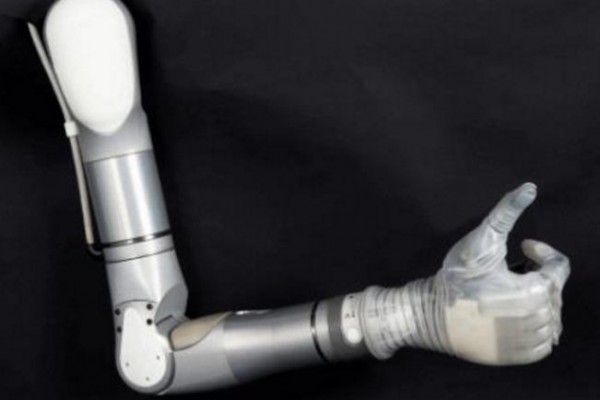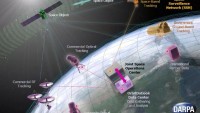‘LUKE’ Mind-controlled Prosthetic Arm from DARPA to be Sold this Year
| Arthur Dominic Villasanta | | Jul 13, 2016 08:56 AM EDT |
(Photo : Mobius Bionics) LUKE mind-controlled arm
"LUKE," a mind-controlled bionic arm originally intended for wounded U.S. soldiers, will instead first be sold to the American public this year.
Named after Luke Skywalker, the mythical hero of the Star Wars saga, the arm was developed with funding from the U.S. Defense Advanced Research Projects Agency (DARPA). In Star Wars Episode IV, Luke Skywalker's right hand was amputated after a light saber duel with the villain, Darth Vader. Skywalker received a bionic right hand in Episode V, The Empire Strikes Back.
Like Us on Facebook
The commercial launch of the LUKE (Life Under Kinetic Evolution) arm system will take place later this year. The arm will be sold for $100,000 and will be marketed by Mobius Bionics LLC. It's being built by Universal Instruments Corporation.
LUKE's forearm-to-shoulder capabilities and advanced features set the prosthetic apart from similar devices. LUKE allows its user to lift a bag of groceries and is dexterous enough to grip delicate items without breaking them.
It can be configured for amputees with limb loss at the shoulder joint, mid-upper arm or mid-lower arm. It isn't appropriate for patients with amputations at the wrist or elbow, however.
It also has a two-way communication system. Electrodes let the user control LUKE's movements with muscle movements as the device transmits grip feedback to the user through a grip-force sensor. This thought-to-action control has led many to describe LUKE as a mind-controlled device. LUKE was tested on 100 amputees.
The LUKE arm was invented by American inventor Dean Kamen at the DEKA Research and Development Corporation and was partly funded by DARPA as part of a $100 million initiative to revolutionize prosthetics. LUKE has been approved for use in humans by the U.S. Food and Drug Administration (FDA).
Kamen is best known for inventing the Segway PT, an electric, self-balancing human transporter with a computer-controlled gyroscopic stabilization and control system.
The LUKE arm system uses electromyogram (EMG) electrodes to receive signals from the patient's muscles and translate them into precise movements. DARPA said the goal of the project that led to LUKE is to improve the functionality of prosthetic limbs and give American servicemen and women who've lost limbs the option of returning to active duty.
LUKE was formerly called the DEKA Arm System because of its clinically proven ability to perform tasks DARPA said weren't possible with existing prosthetic devices. Among these tasks are brushing teeth and cooking meals.
LUKE might allow some people to perform more complex tasks than they can with current prostheses in a way that more closely resembles the natural motion of the arm, said Christy Foreman, director of the Office of Device Evaluation at the FDA's Center for Devices and Radiological Health.
"Up to this point, design in prosthetic arms has been limited to incremental changes. We developed the LUKE arm to change the game for amputees -- creating an innovative, integrated system that offers greater functionality and independence to our wounded warriors and other amputees," said Kamen.
TagsLUKE, Life Under Kinetic Evolution, Dean Kamen, Defense Advanced Research Projects Agency, DARPA
©2015 Chinatopix All rights reserved. Do not reproduce without permission
EDITOR'S PICKS
-

Did the Trump administration just announce plans for a trade war with ‘hostile’ China and Russia?
-

US Senate passes Taiwan travel bill slammed by China
-

As Yan Sihong’s family grieves, here are other Chinese students who went missing abroad. Some have never been found
-

Beijing blasts Western critics who ‘smear China’ with the term sharp power
-

China Envoy Seeks to Defuse Tensions With U.S. as a Trade War Brews
-

Singapore's Deputy PM Provides Bitcoin Vote of Confidence Amid China's Blanket Bans
-

China warns investors over risks in overseas virtual currency trading
-

Chinese government most trustworthy: survey
-

Kashima Antlers On Course For Back-To-Back Titles
MOST POPULAR
LATEST NEWS
Zhou Yongkang: China's Former Security Chief Sentenced to Life in Prison

China's former Chief of the Ministry of Public Security, Zhou Yongkang, has been given a life sentence after he was found guilty of abusing his office, bribery and deliberately ... Full Article
TRENDING STORY

China Pork Prices Expected to Stabilize As The Supplies Recover

Elephone P9000 Smartphone is now on Sale on Amazon India

There's a Big Chance Cliffhangers Won't Still Be Resolved When Grey's Anatomy Season 13 Returns

Supreme Court Ruled on Samsung vs Apple Dispute for Patent Infringement

Microsoft Surface Pro 5 Rumors and Release Date: What is the Latest?













